List of 999 women of the Heritage Floor / Eleanor of Aquitaine
This list describes the place setting for Eleanor of Aquitaine on the table of Judy Chicago's art installation The Dinner Party . It is part of the list of 999 women on the Heritage Floor who are assigned to the respective place settings on the table. The names of the 999 women are on the tiles of the Heritage Floor, which is arranged below the table and belongs to the art installation.
description
The installation consists of a three-sided table, each with 13 historical or mythological personalities, thus a total of 39 people, from prehistory to the women's rights movement . These people were assigned a place setting at the table, consisting of an individually designed table runner, an individually designed plate, a goblet, knife, fork, spoon and serviette. The first page of the table is devoted to prehistory up to the Roman Empire , the second to Christianization up to the Reformation and the third from the American Revolution to the women's movement. Each place setting on the table is assigned additional personalities who have received an entry on the tiles of the Heritage Floor, which occupies the space under the table and the center of the space between the sides of the table. This list includes the personalities assigned to Eleanor of Aquitaine's place setting. Your seat is on the second side of the table.
Hints
In addition to the names as they are used in German transcription or in scientific usage, the list shows the spelling chosen by Judy Chicago on the tiles.
The information on women who do not yet have an article in the German-language Wikipedia is referenced by the individual references listed under comments . If individual information in the table is not referenced via the main article, additional individual references are given at the relevant point. If there are any discrepancies between the information provided in Wikipedia articles and the descriptions of the work of art on the Brooklyn Museum website , this will also be indicated under Comments.
Place setting for Eleanor of Aquitaine
Eleanor of Aquitaine was bornin Poitiers in Poitou around 1122 . She came from the dynasty of the Dukes of Aquitaine , successors to Carolingian kings of Aquitaine and ruler of the largest duchy on French soil. Eleonore married the French heir to the throne Ludwig in 1137. A short time later, Ludwig VI died. On August 8, 1137, Louis VII was crowned and Eleanor became Queen of France. In this marriage two girls were born and in March 1152 it was annulled. In May 1152 she married Heinrich Plantagenet , later King of England, with whom she had eight other children. She is one of the most influential women of the Middle Ages and shaped this period significantly. During her marriage to Heinrich, she pushed for the independent exercise of power, which made the marriage conflictual. She joined the rebellion of three of her sons against their father in 1173/1174 and was placed under house arrest by Heinrich for 15 years. After his death in 1189 during the reign of her two surviving sons Richard Löwenherz and Johann Ohneland , she again assumed an important political role.
Myths and legends were formed about her during her lifetime. So she was accused of adultery with her uncle. She was considered an example of a power-hungry, scheming ruler. This image has changed in the last few decades, not least because of the film The Lion in Winter . Eleanor became the main character in numerous works of fiction . In these a different picture is drawn, she is considered the patroness of poets and minstrels . However, there are no historical sources for this representation. The overall poor source situation makes it difficult to do justice to the historical person Eleanor. As a leitmotif of her life, she is assigned to fulfill her role as queen and to protect the integrity of her Duchy of Aquitaine.
The lily , also the heraldic lily , dominate the Eleanor of Aquitaine table setting on the dinner party table. It is repeated on the front and back of the table runner and adorns the initial letter "E" of your name on the front. The lily is the heraldic symbol for France and is often found in medieval art. She is also a symbol of the Virgin Mary. The lily's deep blue color represents fidelity, the shape of its leaves, reminiscent of blades, suggests that the mother's soul was pierced by the grief for her son. This relates to Mary's conversation with Simeon in Luke ( Lk 2.35 EU ). These allusions are intended to emphasize Eleonore's power as queen.
The table runner was designed similarly to the tapestries by nobles. The images come from the Unicorn Tapestries , one of the most famous and spectacular, but also most puzzling tapestries of the late Middle Ages, which is about mystical unicorns . A gate on the runner surrounds Eleanor's plate. Similar to the way in which the unicorn is set in such a gate in the tapestry, it is intended to indicate on the table runner that Eleanor was imprisoned by her husband Heinrich, while her power as queen is compared with the mystical power of the unicorn. The floral patterns on the runner are derived from the tapestries of the Middle Ages, which were covered with millefleurs , which can also be seen in the unicorn tapestries.
| Surname | Spelling on the tile | Date of birth | cultural spatial assignment | Remarks | image |
|---|---|---|---|---|---|
| Adela from Blois | Adela of Blois | around 1062 | County Blois | Regent to her husband while he was participating in the First Crusade and the 1101 Crusade . Mother of Stephen of Blois , King of England . |

|
| Adelheid from Susa | Adelaide of Susa | around 1014 | Margraviate of Turin | Margravine of Turin and the last of the Arduine family . |

|
| Agnes of Poitou | Agnes of Poitou | 1025 | Holy Roman Empire | After the death of her husband, Emperor Heinrich III. during the minority of her son Heinrich IV. from 1056 to 1061 she was regent of the Roman-German Empire . In 1061 she withdrew from government responsibility after a papal schism , which she contributed to, but continued to secure her son's claims to the throne. |

|
| Almucs de Castelnau | Almucs de Castelnau | around 1140 | French Kingdom , Avignon | A Trobairitz , one of their works, has been preserved. | |
| Barbe de Verrue | Barbe De Verrue | 13th century | French Kingdom , Orléanais | Trobairitz and singer. |

|
| Beatrix de Vesci | Lady Beatrix | 11th century | England | Beatrix de Vesci of Alnwick Castle , noble lady of the house of de Vesci, daughter and sole heir to Ivo de Vesci. | |
| Beatrice de Dia | Beatrice de Die | 12th century | French Kingdom , The | Countess von Die , who was known as Trobairitz . |

|
| Berenguela of Castile | Berenguela | 1180 | Kingdom of Castile | Queen of Castile , Queen of León, patron of religious institutions, responsible for the reunification of Castile and León under the authority of her son and supporter of his efforts during the Reconquista . |

|
| Blanka of Castile | Blanche of Castile | 1188 | Kingdom of France | Queen and temporary regent of France . |
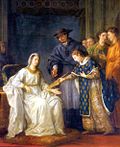
|
| Dervorguilla de Balliol | Dervorguilla | around 1210 | Scotland | 'Lady of substance' in the 13th century in Scotland, mother of John I , King of Scotland. |
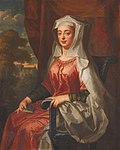
|
| Edith of Scotland | Matilda | around 1080 | Scotland , England | First wife of King Henry I of England , daughter of King Malcolm III of Scotland . and St. Margaret . |
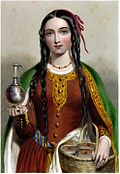
|
| Edith from Wessex | Edith | 1029 | England | Wife of the English King Edward the Confessor and crowned Queen of England. |

|
| Hawise | Hawisa | 12th century | England | Anglo-Norman nobles from the House of Blois . | |
| Isabel de Redvers | Isabella De Forz | 1237 | England | Countess of Devon and Lady of the Isle of Wight in their own right. As a wife, she was named Isabel de Forz or Isabella de Fortibus . |
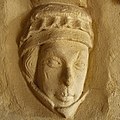
|
| Johanna I. | Jeanne of Navarre | 1273 | Kingdom of Navarre | In her own right from 1274 to 1305, Countess of Champagne and Queen of Navarre, and through her marriage to Philip IV the Handsome, Queen of France from 1285 to 1305. |
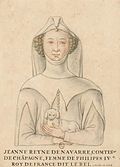
|
| Lady Godiva | Lady Godiva | 11th century | England | Noblewoman who, according to legend, rode naked (only covered with her long hair) through Coventry to convince her husband to cut the tax burden. |

|
| Margaret de Lacy, Countess of Lincoln | Margaret of Lincoln | around 1206 | England | Countess of Lincoln . |

|
| Margaret O'Carroll | Failge | 15th century | Ireland | A 15th-century Gaelic-Irish noblewoman who was remembered primarily for her hospitality and piety. She was nicknamed Mairgréag to Einigh after celebrating two incredible festivals in 1433 and making a pilgrimage to Santiago de Compostela in 1445 . | |
| Margaret of Scotland | Margaret | at 1046/1047 | Scotland | As the wife of Malcolm III. Scottish Queen and Patroness of Scotland. Together with her husband she founded the previous monastery of Dunfermline Abbey . |

|
| Maria | Virgin Mary | 1st century BC Chr. | New Testament , Galilee | Is the mother of Jesus of Nazareth mentioned in the New Testament . She lived with her husband Joseph and other relatives in the small town of Nazareth in Galilee . Mary is particularly venerated in Christianity as the mother of Jesus Christ and is also mentioned in the Koran as the virgin mother of Jesus. |

|
| Maria de Ventadorn | Maria de Ventadorn | 12th century | French Kingdom , Limousin | Trobairitz | |
| Marie de France | Marie de France | around 1135 | Île-de-France , England | Medieval writer of verse novels and fables . |

|
| Marie of Champagne | Marie of Champagne | around 1174 | Kingdom of France , Flanders, Latin Empire | Countess of Flanders and Latin Empress of Constantinople from the House of Blois , daughter of Henry I of Champagne and Marie de France . | |
| Mathilde of Flanders | Matilda of Flanders | around 1030 | England , Flanders | Daughter of Baldwin V and Adela of France , wife of Wilhelm I , Duchess of Normandy, two years after the conquest of England in 1066 as Mathilde I, crowned Queen of England |
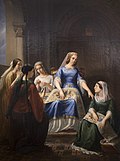
|
| Mathilde of Tuscany | Mathilde of Tuscany | around 1046 | Holy Roman Empire , Tuscany | Margravine of Tuscany at Canossa Castle in the Apennines of Emilia-Romagna , daughter of Boniface of Canossa and Beatrix of Lorraine . |
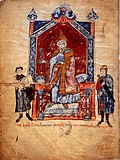
|
| Melisende (Jerusalem) | Melisande | 1105 | Kingdom of Jerusalem | Queen of Jerusalem from 1131 to 1153, daughter of King Baldwin II and the Armenian princess Morphia von Melitene . |

|
| Subh | Sobeya | around 940 | Caliphate of Cordoba | Regent for her son Abu l-Walid Hischam II. Al-Mu'ayyad bi-llah , the third caliph of Cordoba . | |
| Tibors de Sarenom | Fibers | around 1130 | Kingdom of France | The earliest Trobairitz , active in the classical period of Occitan literature of the Middle Ages at the height of the popularity of the troubadours. | |
| Violante from bar | Violante | 1365 | Aragon | Queen of Aragon . Her husband left much of the government to her. |

|
- Individual evidence
- ^ Brooklyn Museum: Eleanor of Aquitaine. In: brooklynmuseum.org. Retrieved October 21, 2019 .
- ↑ Brooklyn Museum: Almucs De Castenau. In: brooklynmuseum.org. Retrieved September 22, 2019 .
- ↑ Brooklyn Museum: Failge. In: brooklynmuseum.org. Retrieved October 20, 2019 .
- ↑ Brooklyn Museum: Maria de Ventadorn. In: brooklynmuseum.org. Retrieved October 21, 2019 .
- ↑ Brooklyn Museum: Sobeya. In: brooklynmuseum.org. Retrieved October 20, 2019 .
- ↑ Brooklyn Museum: Fibors. In: brooklynmuseum.org. Retrieved October 20, 2019 .
Web links
- Brooklyn Museum, Eleanor of Aquitaine
- The Dinner Party on the website of Through the Flower , Judy Chicago's non-profit organization
